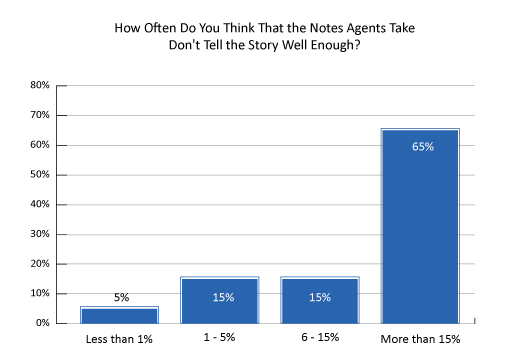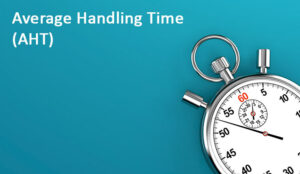Agent notes tell the story of the customer interaction, detailing any issues and the associated resolution, but are they telling the full story?
When Morris asked our LinkedIn Community ‘how often do you think that the notes agents take don’t tell the story well enough?’ 407 industry professionals responded and we wanted to share the results with you.

| Agent Notes Not Telling the Story Well Enough | Response % |
|---|---|
| Less than 1% | 5% |
| 1 – 5% | 15% |
| 6 – 15% | 15% |
| More than 15% | 65% |
Of the responses, around two-thirds stated that in ‘More than 15%’ of cases the notes taken by the agents aren’t telling the story well enough.
This is a surprisingly large percentage of responses and is concerning, as the notes taken by agents are so important to gaining insights into customer experience, service quality, and operational procedures.
This also suggests additional problems are being faced across the same contact centre by other agents trying to continue customer conversations on subsequent contacts.
A good note clearly explains what happened, why, and any actions taken by the agent – but as only 5% said their agents notes were lacking ‘Less than 1%’ of the time, there is clearly room for improvement within the industry.
The results also reveal that many contact centres are still relying on agents to provide manual notes, which takes time and can vary significantly by agent – despite significant enhancements in available time-saving technology in this space.
To delve deeper into this, we’ve put together a number of the comments that were also provided by the respondents:
Fault Lies With the Managers
The fault is with the managers. Train them better and the agents will execute what is needed. Don’t blame them for your mistakes.
Thanks to Chris
Allotted ACW Time Plays a Role
I’ve literally only had one agent who had enough wrap-up notes. Most times, it’s not even close to enough but it’s what they can do in their allotted after-call work (ACW).
Thanks to Tamika
There Isn’t Enough Allocated Wrap Time
I’d wager a significant number of agents simply don’t have enough allocated wrap time to be able to write accurate and detailed notes.
Contact centres are mainly seen as cost centres, so use quantitative measures to report performance, mainly based on average speed to answer, average call duration, and wrap time adherence.
Contact centres are mainly seen as cost centres, so use quantitative measures to report performance, mainly based on average speed to answer, average call duration, and wrap time adherence.
Those contact centres that have moved to being profit centres tend to use a mix of quantitative and qualitative measures to gauge customer satisfaction, First Call Resolution (FCR) and renewals. I guess the short answer is to give the people the time and trust to do their jobs properly.
Thanks to Lee
AHT Is an Average
It feels to me that people manage AHT by ‘beating’ the agents with a stick. AHT is an average. Some of course will be over, some under.
Instead of spending time working to a number, we should be working to understand what a good contact looks like, and coaching and supporting our agents, improving tools to enable them to hit the average.
Thanks to Catherine
High Call Volume Reduces Quality of Notes
I’ve worked as a call centre agent for a couple of years. All my metrics were almost perfect, but I couldn’t beat the AHT.
They saw nothing but that one metric I couldn’t meet – even if I had almost perfect surveys, very low callbacks (meaning I resolved issues long-term), and a great upsell rate.
When there’s a high number of calls coming in, there’s not even a second between calls. No time to provide a detailed explanation of what happened for the next agent. So when customers call again and repeat their concerns, they end up getting really frustrated.
Thanks to Jashmene
Use Ongoing Peer-Based Comparison
We always advise ongoing peer-based comparison across a balanced scorecard – AHT may be used as just one of the appropriate productivity-related KPIs or ‘diagnostic’ sub-measures (in addition to CSAT (or other), Quality and, potentially, commercial measures).
This enables an empirical/evidence-based approach to determining ‘what good looks like’ at any given time while neutralizing external ‘noise’ such as seasonality, etc.
That way if, for example, the nature of a certain call type changes on a given day, you observe how it affects the AHT (and other measures) for everyone in the peer group.
Thus, if everyone’s AHT in a given group increases by, say, 15s for a certain call type one day, you don’t worry about their performance not hitting some arbitrary target (although, of course, you should conduct root-cause analysis to determine why AHT has increased for all).
It’s the outliers that should be the focus and, once again, in the context of the balanced scorecard.
Thanks to Keir
Leaders Should Be Looking to Make the Agent’s Life as Easy as Possible
I find it interesting that many organizations overlook existing workflow “potential” that could be realized by enhancing CRM connectors or utilizing real-time transcription and quality analysis to pull keywords out and proactively suggest next steps and position the system of record in a sequence of success.
Leaders should be looking for places to make the agent’s life as easy as possible.
I do think agents could be more invested in taking the appropriate amount of time to engage, though I think that is more cultural. Us as leaders should be looking for places to make the agent’s life as easy as possible.
Thanks to Travis
Technology Could Potentially Reduce This Issue
Technology does have the potential to significantly reduce this issue, but only if it’s capable of true omnichannel interaction, so across all contact channels and feeding into the same CRM; this way the agent will have the ability to read the customer’s journey and eliminate wasted, and infuriating, questions and update notes post-call in context of that history.
Thanks to Lee
Author: Robyn Coppell
Published On: 18th May 2023
Read more about - Contact Centre Research, After Call Work (ACW), Average Handling Time (AHT), Customer Service, Polls







































